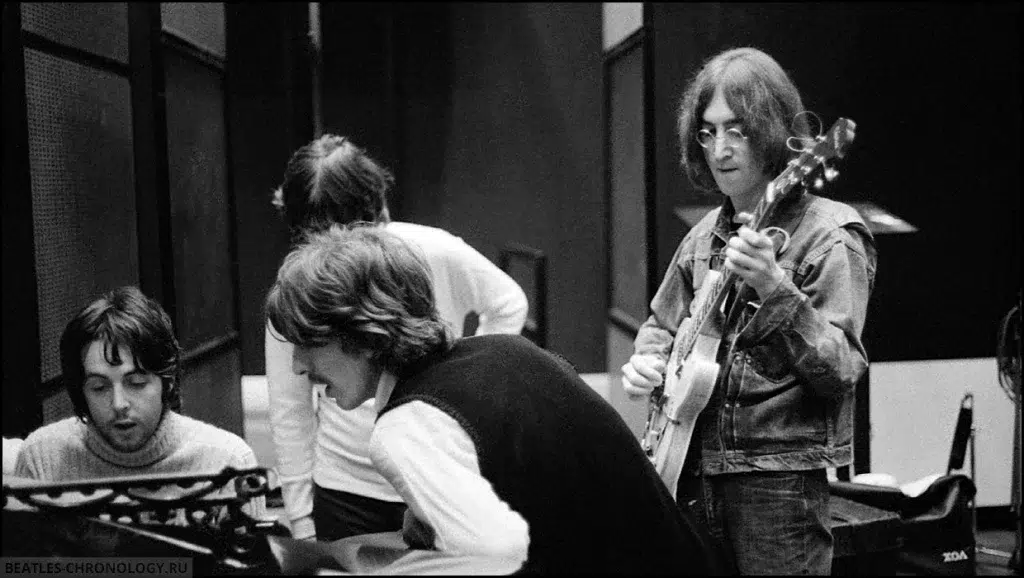Tuesday, October 1, 1968
Recording and mixing "Honey Pie"
For The Beatles
Last updated on November 13, 2024
Tuesday, October 1, 1968
For The Beatles
Last updated on November 13, 2024
"The Beatles" (aka the White Album) sessions
May 30 - Oct 18, 1968 • Songs recorded during this session appear on The Beatles (Mono)
Recording studio: Trident Studios, London, UK
Previous session Sep 26, 1968 • Mixing "Happiness Is A Warm Gun", "What's The New Mary Jane", "Glass Onion", "I Will"
Article Sep 30, 1968 • Hunter Davies' authorized Beatles biography released in the UK
Article Fall 1968 • Apple faces business problems
Session Oct 01, 1968 • Recording and mixing "Honey Pie"
Session Oct 02, 1968 • Recording "Honey Pie"
AlbumSome of the songs worked on during this session were first released on the "The Beatles (Mono)" LP
For this new week of recording for the White Album, The Beatles returned to Trident Studios. They had previously spent time there from August 31 to August 6 to record “Hey Jude,” taking advantage of the studio’s eight-track recording facilities, which were not yet available at EMI Studios on Abbey Road. However, by October, EMI Studios had made eight-track recording capabilities available to The Beatles. Mark Lewisohn suggests that The Beatles were simply seeking “a change of scenery.”
On that day, The Beatles began work on Paul McCartney’s “Honey Pie.” By the end of the day, they had recorded the basic track with Paul McCartney on piano, George Harrison on bass, John Lennon on electric guitar, and Ringo Starr on drums.
Despite filling two reels of tape with rehearsals, the session was labeled Take 1. It was a common practice at Trident Studios to label the best take as Take 1.
George Martin, assisted by engineer Barry Sheffield, created a rough mono mix for himself to compose the brass and woodwind arrangement.
The work on “Honey Pie” resumed the following day.






Recording • Take 1
Mixing • Mono mixing - rough remix from take 1
The Complete Beatles Recording Sessions • Mark Lewisohn
The definitive guide for every Beatles recording sessions from 1962 to 1970.
We owe a lot to Mark Lewisohn for the creation of those session pages, but you really have to buy this book to get all the details - the number of takes for each song, who contributed what, a description of the context and how each session went, various photographies... And an introductory interview with Paul McCartney!
The Beatles Recording Reference Manual: Volume 4: The Beatles through Yellow Submarine (1968 - early 1969)
The fourth book of this critically acclaimed series, "The Beatles Recording Reference Manual: Volume 4: The Beatles through Yellow Submarine (1968 - early 1969)" captures The Beatles as they take the lessons of Sgt. Pepper forward with an ambitious double-album that is equally innovative and progressive. From the first take to the final remix, discover the making of the greatest recordings of all time. Through extensive, fully-documented research, these books fill an important gap left by all other Beatles books published to date and provide a unique view into the recordings of the world's most successful pop music act.
If we modestly consider the Paul McCartney Project to be the premier online resource for all things Paul McCartney, it is undeniable that The Beatles Bible stands as the definitive online site dedicated to the Beatles. While there is some overlap in content between the two sites, they differ significantly in their approach.

Notice any inaccuracies on this page? Have additional insights or ideas for new content? Or just want to share your thoughts? We value your feedback! Please use the form below to get in touch with us.